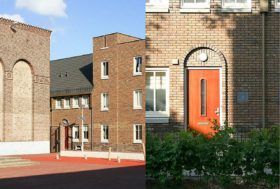 27 June 2017 – On the Archined website Elmar Koers discusses the Kloosterbuuren project. ‘The spatial quality of the new ensemble is high. In masterly fashion, Van der Heijden makes alleys, streets and a square with the most simple means: the proximity of the new blocks to the old buildings.’
27 June 2017 – On the Archined website Elmar Koers discusses the Kloosterbuuren project. ‘The spatial quality of the new ensemble is high. In masterly fashion, Van der Heijden makes alleys, streets and a square with the most simple means: the proximity of the new blocks to the old buildings.’
Fortunately, Elmar does not leave it at compliments. He poses a problem. As a young architect he notes that the project is built with everyday structures: ‘steel lintels under the bricks, concrete sills and copings, aluminium cornices, sober window profiles, a base of the buildings which is “merely” articulated in a darker shade of brickwork. After 1,5 years of practical experience in it is becoming clear to me that this is unavoidable Dutch housing practice, but I still cannot get used to it.’
He asks himself how architects can learn to develop such intuitions for building it they cannot do so at their schools. He concludes: ‘Sadly, it seems that we have to turn our eyes to the past for that, the here and now offers to little grip. A tour through almost every city centre in The Netherlands or any other European town feels suddenly as a lecture by our predicessors. In The Hague it is Van der Laan (architect of the remaining monastic buildings, HvdH) who is giving the lecture, Hans van der Heijden is the next speaker in line.’
Building matter.